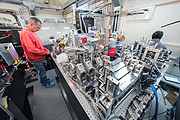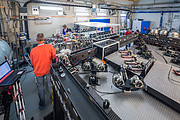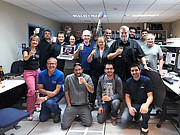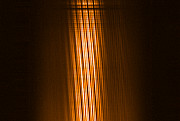Press Release
MATISSE Instrument Sees First Light on ESO’s Very Large Telescope Interferometer
Most powerful interferometric instrument ever at mid-infrared wavelengths
5 March 2018
The new MATISSE instrument on ESO’s Very Large Telescope Interferometer (VLTI) has now successfully made its first observations at the Paranal Observatory in northern Chile. MATISSE is the most powerful interferometric instrument in the world at mid-infrared wavelengths. It will use high-resolution imaging and spectroscopy to probe the regions around young stars where planets are forming as well as the regions around supermassive black holes in the centres of galaxies. The first MATISSE observations used the VLTI’s Auxiliary Telescopes to examine some of the brightest stars in the night sky, including Sirius, Rigel and Betelgeuse, and showed that the instrument is working well.
MATISSE (Multi AperTure mid-Infrared SpectroScopic Experiment) observes infrared light — light between the visible and microwave wavelengths of the electromagnetic spectrum, covering wavelengths from 3–13 micrometres (µm) [1]. It is a second-generation spectro-interferometer instrument for ESO’s Very Large Telescope that can take advantage of multiple telescopes and the wave nature of the light. In this way, it produces more detailed images of celestial objects than can be obtained with any existing or planned single telescope at these wavelengths.
After 12 years of development by a large number of engineers and astronomers in France, Germany, Austria, the Netherlands and at ESO, and following an extensive period of demanding work installing and testing this very complex instrument, initial observations have now confirmed that MATISSE is working as expected [2].
The initial MATISSE observations of the red supergiant star Betelgeuse, which is expected to explode as a supernova in a few hundred thousand years, showed that it still has secrets to reveal [3]. The new observations show evidence that the star appears to have a different size when seen at different wavelengths. Such data will allow astronomers to further study the huge star’s surroundings and how it is shedding material into space.
The principal investigator of MATISSE, Bruno Lopez (Observatoire de la Côte d’Azur (OCA), Nice, France), explains its unique power: “Single telescopes can achieve image sharpness that is limited by the size of their mirrors. To obtain even higher resolution, we combine — or interfere — the light from four different VLT telescopes. Doing this enables MATISSE to deliver the sharpest images of any telescope ever in the 3–13 μm wavelength range, where it will complement the James Webb Space Telescope’s future observations from space.”
MATISSE will contribute to several fundamental research areas in astronomy, focusing in particular on the inner regions of discs around young stars where planets are forming, the study of stars at different stages of their lives, and the surroundings of supermassive black holes at the centres of galaxies.
Thomas Henning, director at the Max Planck Institute for Astronomy (MPIA) in Heidelberg, Germany, and MATISSE co-principal investigator, comments: "By looking at the inner regions of protoplanetary discs with MATISSE, we hope to learn the origin of the various minerals contained in these discs — minerals that will later go on to form the solid cores of planets like the Earth.”
Walter Jaffe, the project scientist and co-principal investigator from University of Leiden in the Netherlands, and Gerd Weigelt, co-principal investigator from the Max Planck Institute for Radio Astronomy (MPIfR), Bonn, Germany, add: “MATISSE will give us dramatic images of planet-forming regions, multiple stars, and, when working with the VLT Unit Telescopes, also the dusty discs feeding supermassive black holes. We hope also to observe details of exotic objects in our Solar System, such as volcanoes on Io, and the atmospheres of giant exoplanets.”
MATISSE is a four-way beam combiner, meaning it combines the light collected from up to four of the 8.2-metre VLT Unit Telescopes or up to four of the Auxiliary Telescopes (ATs) that make up the VLTI, performing both spectroscopic and imaging observations. In doing so, MATISSE and the VLTI together possess the imaging power of a telescope up to 200 metres in diameter, capable of producing the most detailed images ever at mid-infrared wavelengths.
Initial tests were made with the Auxiliary Telescopes, and further observations with the four VLT Unit Telescopes are planned during the next few months.
MATISSE superimposes the light of an astronomical object from the combined light of multiple telescopes, resulting in an interference pattern that contains information about the appearance of the object, from which an image can then be reconstructed.
MATISSE’s first light marks a big step forward in the scope of current optical/infrared interferometers and will allow astronomers to obtain interferometric images with finer detail over a wider wavelength range than currently possible. MATISSE will also complement the instruments planned for ESO’s upcoming Extremely Large Telescope (ELT), in particular METIS (the Mid-infrared ELT Imager and Spectrograph). MATISSE will observe brighter objects than METIS, but with higher spatial resolution.
Andreas Glindemann, MATISSE project manager at ESO, concludes: “Making MATISSE a reality has involved the work of many people over many years and it is wonderful to see the instrument working so well. We are looking forward to the exciting science to come!”
Notes
[1] MATISSE was designed, funded and built in close collaboration with ESO, by a consortium composed of institutes in France (J.-L. Lagrange Laboratory — INSU-CNRS — Côte d’Azur Observatory — University of Nice Sophia-Antipolis), Germany (MPIA, MPIfR and University of Kiel), the Netherlands (NOVA and University of Leiden), and Austria (University of Vienna). The Konkoly Observatory and Cologne University have also provided some support in the manufacture of the instrument.
[2] With MATISSE, the last of the suite of second generation VLT/VLTI instruments has now arrived at Paranal. For the VLTI this means that 17 years — almost exactly to the day — after obtaining first fringes with VINCI and two siderostats, the first generation of instruments has now been replaced by PIONIER, GRAVITY and MATISSE, all of them combining four telescopes (UTs or ATs) and together covering a wide range of infrared wavelengths (from 1.6–13 µm). MATISSE is the first mid-infrared interferometer that can be used to reconstruct images.
[3] Betelgeuse was the first star resolved by interferometry by Michelson and Pease in 1920. It was also used as a bright test case by precursor mid-infrared interferometers — including MIDI on the VLTI.
More information
ESO is the foremost intergovernmental astronomy organisation in Europe and the world’s most productive ground-based astronomical observatory by far. It is supported by 16 countries: Austria, Belgium, Brazil, Czechia, Denmark, France, Finland, Germany, Italy, the Netherlands, Poland, Portugal, Spain, Sweden, Switzerland and the United Kingdom, along with the host state of Chile and by Australia as a strategic partner. ESO carries out an ambitious programme focused on the design, construction and operation of powerful ground-based observing facilities enabling astronomers to make important scientific discoveries. ESO also plays a leading role in promoting and organising cooperation in astronomical research. ESO operates three unique world-class observing sites in Chile: La Silla, Paranal and Chajnantor. At Paranal, ESO operates the Very Large Telescope, the world’s most advanced visible-light astronomical observatory and two survey telescopes. VISTA works in the infrared and is the world’s largest survey telescope and the VLT Survey Telescope is the largest telescope designed to exclusively survey the skies in visible light. ESO is a major partner in ALMA, the largest astronomical project in existence. And on Cerro Armazones, close to Paranal, ESO is building the 39-metre Extremely Large Telescope, the ELT, which will become “the world’s biggest eye on the sky”.
Links
Contacts
Andreas Glindemann
ESO
Garching bei München, Germany
Tel: +49-89-32006-590
Email: aglindem@eso.org
Paul Bristow
ESO
Garching bei München, Germany
Tel: +49-89-32006-506
Email: bristowp@eso.org
Bruno Lopez
Laboratoire J.-L. Lagrange, Observatoire de la Côte d'Azur
Nice, France
Tel: +33 4 92 00 31 46
Email: bruno.lopez@oca.eu
Stéphane Lagarde
Laboratoire J.-L. Lagrange, Observatoire de la Côte d'Azur
Nice, France
Tel: +33 4 92 00 31 46
Email: stephane.lagarde@oca.eu
Richard Hook
ESO Public Information Officer
Garching bei München, Germany
Tel: +49 89 3200 6655
Cell: +49 151 1537 3591
Email: rhook@eso.org
About the Release
| Release No.: | eso1808 |
| Name: | MATISSE |
| Type: | Unspecified : Technology : Observatory : Instrument |
| Facility: | Very Large Telescope Interferometer |
| Instruments: | MATISSE |
Our use of Cookies
We use cookies that are essential for accessing our websites and using our services. We also use cookies to analyse, measure and improve our websites’ performance, to enable content sharing via social media and to display media content hosted on third-party platforms.
ESO Cookies Policy
The European Organisation for Astronomical Research in the Southern Hemisphere (ESO) is the pre-eminent intergovernmental science and technology organisation in astronomy. It carries out an ambitious programme focused on the design, construction and operation of powerful ground-based observing facilities for astronomy.
This Cookies Policy is intended to provide clarity by outlining the cookies used on the ESO public websites, their functions, the options you have for controlling them, and the ways you can contact us for additional details.
What are cookies?
Cookies are small pieces of data stored on your device by websites you visit. They serve various purposes, such as remembering login credentials and preferences and enhance your browsing experience.
Categories of cookies we use
Essential cookies (always active): These cookies are strictly necessary for the proper functioning of our website. Without these cookies, the website cannot operate correctly, and certain services, such as logging in or accessing secure areas, may not be available; because they are essential for the website’s operation, they cannot be disabled.
Functional Cookies: These cookies enhance your browsing experience by enabling additional features and personalization, such as remembering your preferences and settings. While not strictly necessary for the website to function, they improve usability and convenience; these cookies are only placed if you provide your consent.
Analytics cookies: These cookies collect information about how visitors interact with our website, such as which pages are visited most often and how users navigate the site. This data helps us improve website performance, optimize content, and enhance the user experience; these cookies are only placed if you provide your consent. We use the following analytics cookies.
Matomo Cookies:
This website uses Matomo (formerly Piwik), an open source software which enables the statistical analysis of website visits. Matomo uses cookies (text files) which are saved on your computer and which allow us to analyze how you use our website. The website user information generated by the cookies will only be saved on the servers of our IT Department. We use this information to analyze www.eso.org visits and to prepare reports on website activities. These data will not be disclosed to third parties.
On behalf of ESO, Matomo will use this information for the purpose of evaluating your use of the website, compiling reports on website activity and providing other services relating to website activity and internet usage.
Matomo cookies settings:
Additional Third-party cookies on ESO websites: some of our pages display content from external providers, e.g. YouTube.
Such third-party services are outside of ESO control and may, at any time, change their terms of service, use of cookies, etc.
YouTube: Some videos on the ESO website are embedded from ESO’s official YouTube channel. We have enabled YouTube’s privacy-enhanced mode, meaning that no cookies are set unless the user actively clicks on the video to play it. Additionally, in this mode, YouTube does not store any personally identifiable cookie data for embedded video playbacks. For more details, please refer to YouTube’s embedding videos information page.
Cookies can also be classified based on the following elements.
Regarding the domain, there are:
- First-party cookies, set by the website you are currently visiting. They are stored by the same domain that you are browsing and are used to enhance your experience on that site;
- Third-party cookies, set by a domain other than the one you are currently visiting.
As for their duration, cookies can be:
- Browser-session cookies, which are deleted when the user closes the browser;
- Stored cookies, which stay on the user's device for a predetermined period of time.
How to manage cookies
Cookie settings: You can modify your cookie choices for the ESO webpages at any time by clicking on the link Cookie settings at the bottom of any page.
In your browser: If you wish to delete cookies or instruct your browser to delete or block cookies by default, please visit the help pages of your browser:
Please be aware that if you delete or decline cookies, certain functionalities of our website may be not be available and your browsing experience may be affected.
You can set most browsers to prevent any cookies being placed on your device, but you may then have to manually adjust some preferences every time you visit a site/page. And some services and functionalities may not work properly at all (e.g. profile logging-in, shop check out).
Updates to the ESO Cookies Policy
The ESO Cookies Policy may be subject to future updates, which will be made available on this page.
Additional information
For any queries related to cookies, please contact: pdprATesoDOTorg.
As ESO public webpages are managed by our Department of Communication, your questions will be dealt with the support of the said Department.









